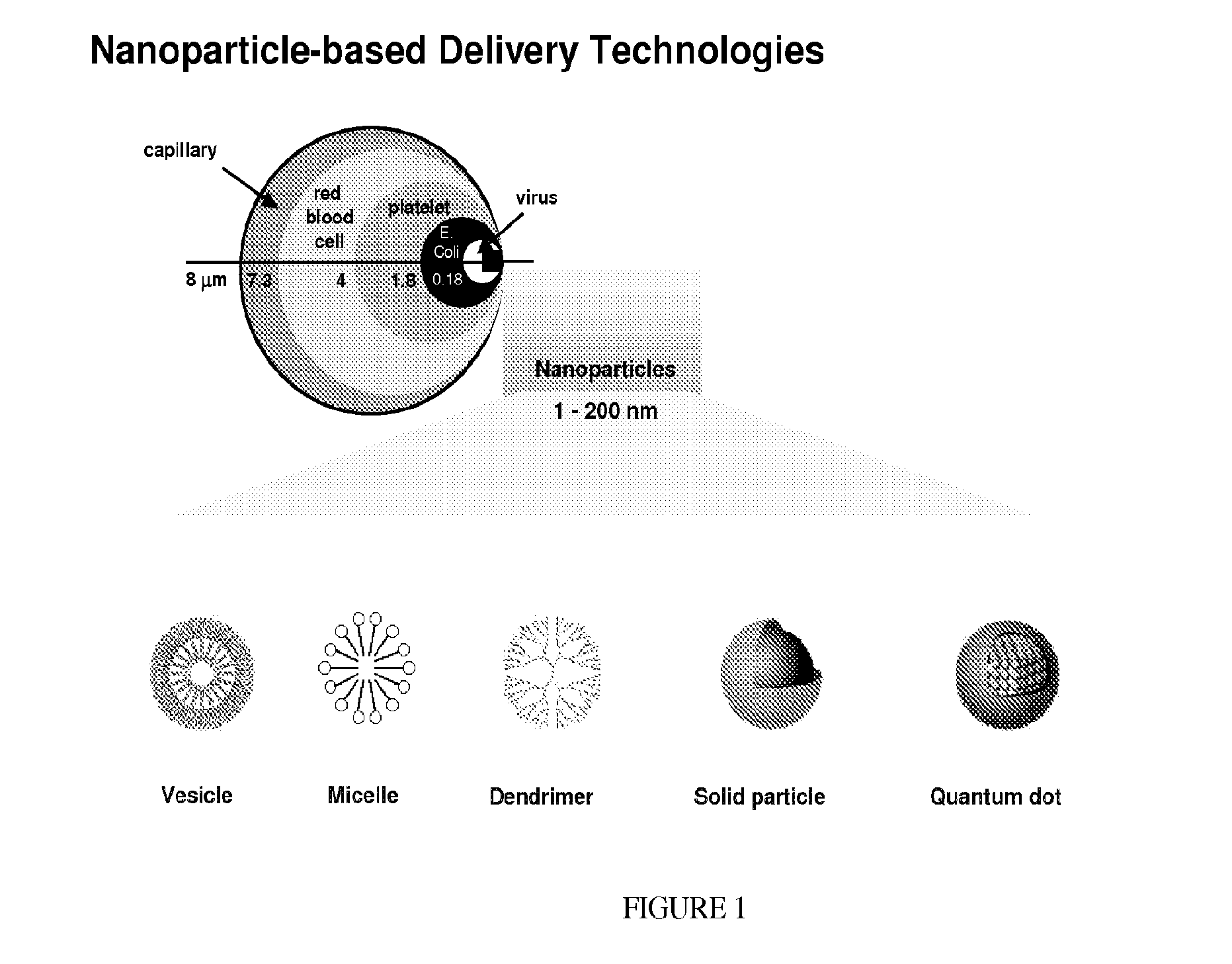Compositions And Methods For Treating Or Preventing Immuno-Inflammatory Disease
a technology for immunoinflammatory diseases and compositions, applied in the direction of biocide, drug compositions, therapies, etc., can solve the problems of reduced frequency of drug-associated in vivo toxicities, difficult incorporation of large amounts of molecular agents in water, and significant challenges in dosage formulation and therapeutic applications, so as to facilitate specific biological adhesion, facilitate dissolved water, and be more economically feasible
- Summary
- Abstract
- Description
- Claims
- Application Information
AI Technical Summary
Benefits of technology
Problems solved by technology
Method used
Image
Examples
example 1
Encapsulation of Resveratrol in Poly(Ethylene Oxide)-Poly(Caprolactone) Polymersomes
[0063]A poly (ethylene oxide)-β-poly(caprolactone) (PEO-b-PCL) diblock copolymer of average molecular weight from about 10 kD to about 20 kD was mixed with resveratrol (>99% purity) in weight ratios from 1:1 to 10:1 (polymer:resveratrol) in a scintillation vial. Weight percentage of PEO block in PEO-b-PCL copolymer ranged from 10 to 25%. The mixture was dissolved in a suitable organic solvent (e.g. methylene chloride, tetrahydrofuran, dimethyl sulfoxide) to produce about 0.5-2 mM solution of PEO-b-PCL copolymer. The mixture was gently shaken to produce a clear solution. About 100-500 μl of the solution was transferred on a roughened Teflon™ strip (approximately 1″×1″× 1 / 16″ thick) and the strip was deposited on the bottom of a glass vial with roughened side facing up. The solvent was evaporated under vacuum at ambient temperature for 24-48 hrs to obtain dried film of copolymer embedded with resveratr...
example 2
Encapsulation of Resveratrol in Poly (Ethylene Oxide)-Polybutadiene Polymersomes
[0065]A poly (ethylene oxide)-b-poly(butadiene) (PEO-b-PBD) diblock copolymer of average molecular weight from about 3 kD-15 kD was mixed with resveratrol (>99% purity) in weight ratios from 1:1 to 10:1 (polymer:resveratrol) in a scintillation vial. Weight percentage of PEO block in PEO-b-PBD copolymer ranged from 10 to 40%. The mixture was dissolved in a suitable organic solvent (e.g. methylene chloride, tetrahydrofuran, dimethyl sulfoxide) to produce about 0.5-2 mM solution of PEO-b-PBD copolymer. The mixture was gently shaken to produce a clear solution. About 100-500 μl of the solution was transferred on a roughened Teflon™ strip and the strip was deposited on the bottom of a glass vial with roughened side facing up. The solvent was evaporated under vacuum at ambient temperature for 24-48 hrs to obtain dried film of copolymer embedded with resveratrol.
[0066]These films were hydrated with 1-5 ml of su...
example 3
Encapsulation of Resveratrol in Poly (Ethylene Oxide)-Poly (Gamma-Methyl-Epsilon-Caprolactone) Polymersomes
[0067]A poly (ethylene oxide)-β-poly(gamma-methyl-epsilon-caprolactone) (PEO-b-PMCL) diblock copolymer of average molecular weight from about 5 kD-14 kD was mixed with resveratrol (>99% purity) in weight ratios from 1:1 to 10:1 (polymer:resveratrol) in a scintillation vial. Weight percentage of PEO block in PEO-b-PMCL copolymer ranged from 20 to 40%. The mixture was dissolved in a suitable organic solvent (e.g. methylene chloride, tetrahydrofuran, dimethyl sulfoxide) to produce about 0.5-2 mM solution of PEO-b-PMCL copolymer. The mixture was gently shaken to produce a clear solution. About 100-500 μl of the solution was transferred on a roughened Teflon™ strip and the strip was deposited on the bottom of a glass vial with roughened side facing up. The solvent was evaporated under vacuum at ambient temperature for 24-48 hrs to obtain dried film of copolymer embedded with resvera...
PUM
| Property | Measurement | Unit |
|---|---|---|
| weight fraction | aaaaa | aaaaa |
| weight fraction | aaaaa | aaaaa |
| weight fraction | aaaaa | aaaaa |
Abstract
Description
Claims
Application Information
 Login to View More
Login to View More - R&D
- Intellectual Property
- Life Sciences
- Materials
- Tech Scout
- Unparalleled Data Quality
- Higher Quality Content
- 60% Fewer Hallucinations
Browse by: Latest US Patents, China's latest patents, Technical Efficacy Thesaurus, Application Domain, Technology Topic, Popular Technical Reports.
© 2025 PatSnap. All rights reserved.Legal|Privacy policy|Modern Slavery Act Transparency Statement|Sitemap|About US| Contact US: help@patsnap.com



